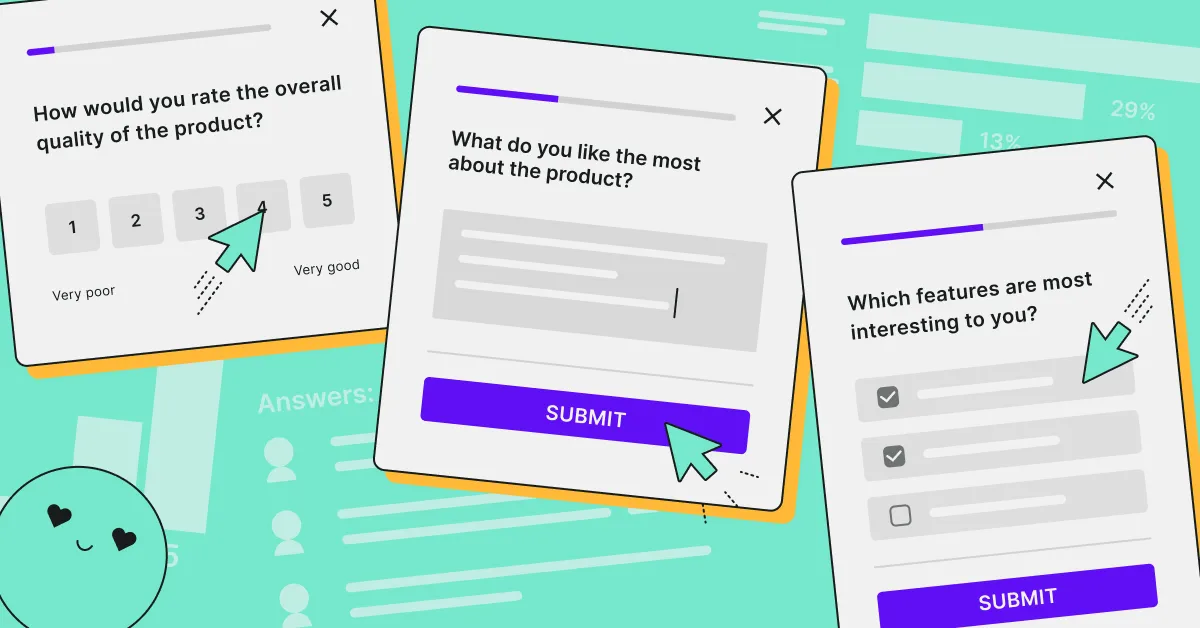tl;dr
- Use market research tools to understand consumer preferences, define the target audience, and analyze competitors.
- Develop a detailed marketing strategy, including advertising, PR, and social media campaigns. Plan a launch event to create buzz and ensure sales channels are primed.
- Collect and analyze real-time feedback from early adopters to refine marketing strategies and sales approaches. Adjust based on customer interactions to optimize product success.
- Set clear, achievable goals and conduct market and pricing research. Develop a unique value proposition, user segmentation and establish a solid digital experience strategy.
- Execute marketing and communication strategies, engage with customers, monitor product experience, and gather customer feedback. Update product documentation and prioritize improvements based on feedback.
Launching a new product is a significant milestone for any business, and the process is fraught with both excitement and challenges. To ensure a successful product launch, it is crucial to have a well-structured product launch checklist.
This checklist serves as a comprehensive guide, detailing each step that needs to be executed carefully. Adhering to this product launch checklist minimizes the risk of overlooking critical components and increases the likelihood of a successful market introduction.

What is the Product Launch Checklist?
Your product launch checklist is a strategic plan that outlines all necessary actions to take before, during, and after releasing a product to the market. It's a roadmap that helps you align your team, set clear objectives, and establish a timeline for your launch activities.
As you approach the launch date, this checklist, much like the spirit of National Checklist Day, will be your go-to guide for keeping the process systematic and ensuring that nothing is left to chance.
Some key elements to include in your product launch checklist are thorough market research, target audience and buyer personas identification, marketing strategy development, distribution channel planning, pricing strategy, positioning statement, and post-launch analysis.
Incorporating these elements helps you create a more resilient product launch strategy, enabling you to track progress and adapt quickly to any unforeseen challenges. By moving through your product launch checklist methodically, you set up your product—and your business—for a better chance of success.
A product launch checklist is a comprehensive set of tasks dedicated to all teams so you can easily align marketing efforts and engineering teams, organized in a strategic sequence.
This systematic approach helps ensure that no critical steps are overlooked and that every aspect of the launch is managed with attention to detail. The product launch checklist is both a strategic blueprint and a practical guide that will lead you through the complexities of launching a product.
What Should You Know Before Diving into Product Launch Checklists?
A successful product launch is methodical and well-executed, ensuring that every box is checked for maximum market impact and reaches potential customers.
Your product launch checklist will serve as a roadmap to navigate the launch process, keeping you informed and prepared at each step.
Here's a quick summary of product launch checklist. For a detailed step by step guide, move to the next sections.
Before Market Entry Essentials:
- Research: Conduct market studies to understand consumer needs and preferences.
- Define Target Audience: Identify and characterize your ideal customer base.
- Competitive Analysis: Analyze competitors to establish your product’s unique value proposition.
Product Readiness Basics:
- Quality Checks: Confirm the product meets quality standards and regulatory requirements.
- Packaging: Ensure the packaging is secure and appealing to consumers.
- Inventory: Prepare sufficient stock to meet anticipated demand.
Product Marketing and Promotion Fundamentals:
- Develop a marketing strategy that details advertising, public relations, and promotional activities.
- Create compelling marketing content: website copy, blog posts, and marketing materials.
- Plan the launch event, if applicable, to generate excitement and media coverage.
Sales Channels:
- Ensure retailers or online sales platforms are ready for the product release.
- Train the sales team to advocate effectively for the product's features and benefits.
Post-Launch Plan:
- Collect and analyze feedback from early adopters.
- Adjust marketing strategies and sales tactics based on consumer responses.
Role of Product Launch Checklist in Organization
A product launch checklist is an indispensable tool for organizations aiming to introduce new products to the market with precision and confidence.
This comprehensive list serves as a roadmap, guiding teams through the intricate process of bringing a product from concept to consumer. It ensures that every critical step, from market research and product development to marketing strategies and distribution channels, is meticulously planned and executed.
By adhering to a well-structured product launch checklist, companies can avoid common pitfalls, synchronize cross-departmental efforts, and align their launch activities with overarching business goals.
This strategic approach not only enhances the chances of successful product launches but also streamlines communication, optimizes resource allocation, and facilitates a thorough analysis of the launch's effectiveness post-deployment.
How to Use Product Launch Checklist?
A product launch checklist helps you navigate your product launch effectively. This strategy is crucial for your go-to-market strategy.
Start by identifying your target audience and ensuring your product meets their needs for customer satisfaction. This phase is about understanding who will benefit most from your product and tailoring your go-to-market strategy accordingly.
Next, establish a clear product launch strategy. This should detail every step, from the initial product concept to the post-launch review.
Use a checklist format for each phase: pre-launch, launch, and post-launch. Organize tasks in a logical order, assign responsibilities, and set deadlines.
Here's a simplified product launch checklist structure:
Pre-launch Activities:
- Conduct Market Research: Understand your audience and their needs through market research.
- Branding: Develop your product's branding materials before product launch.
- Content Marketing: Prepare marketing campaigns, blog posts, press releases, and social media content.
Product Launch Day
- Website and Sales Channels: Ensure all platforms are live and functional.
- Customer Service Prep: Train your team to handle inquiries and feedback.
- Promotion: Execute promotional campaigns and launch event.
Post-launch Activities:
- Gather Feedback: Measure customer satisfaction and respond to feedback.
- Data Analysis: Review product launch performance metrics against your goals.
- Iterate: Identify improvements for your product and marketing.
Review and refine your product launch checklist as you progress, tailoring it to your unique product and market. Regularly check off completed tasks and stay adaptable, tweaking your strategy based on real-time market feedback.
Remember to engage with your audience throughout the product launch, keeping them informed and excited about your offerings. Communication is key to maintaining interest and building a loyal customer base.
Incorporating these steps will help you execute a successful product launch, supported by a solid strategy and customer-focused approach.
Successful Launch Checklist: Pre-Launch Activities
Prior to launching your product, it is essential to meticulously plan and prepare a variety of tasks to ensure a successful market entry.
This checklist will provide you with the detailed steps necessary for your pre-launch activities.
This product launch checklist encompasses the key pre-launch activities integral to orchestrating a successful product launch. By following these steps, you are setting a strong foundation for your product's market performance.
Define the Product Launch Goals
Firstly, determine what you hope to achieve with your product launch. These goals will guide your strategy and give you metrics to measure success.
Establish SMART Goals
Your launch goals should be Specific, Measurable, Achievable, Relevant, and Time-bound to ensure they are actionable and attainable.
Conduct Market Research and Audience Analysis
Understanding your target market and audience is crucial. Analyze demographics, needs, and preferences so you can create buyer personas and tailor your message accordingly.

Perform a Competitor Research
Investigate your competitors to identify what they do well and where there are gaps. This information helps you differentiate your product.
Set a Product Launch Date
Set a realistic product launch date based on product development and the time required for planning and preparation. This will help you align the the whole team on all activities that must be completed before the product launch.
Understand Customer Needs
Dialogue with your customers to learn about their needs and how your product can address them. This step will be crucial to maintain high customer satisfaction.
Define Product Positioning
Position your product effectively in the market by considering its unique features and how it fits into the existing landscape.
Consider market and competitive research findings to propose a unique value that you can use to create promotional content.
Craft the Positioning Statement
Create a clear and concise statement that defines where your product fits within the market and what makes it special.
Build the Unique Value Proposition
Identify the distinct benefits your product offers and why it is the preferred choice for your target audience.
Develop and Test
Develop initial versions of your product and conduct rigorous testing to ensure it meets quality standards.
MVP and Beta Testing
Build a Minimum Viable Product (MVP) and/or Beta version to gather feedback and make necessary improvements.
Plan Marketing and Promotional Strategies
Develop a comprehensive go-to-market strategy, including timelines, channels, and tools necessary to promote your product.
Plan Social Media and PR Strategy
Consider SM communication when crafting a go-to-market plan to create conversation and interest about your product.
Create Marketing Content
Develop compelling promotional content such as blog posts, product videos, and infographics that can engage your target audience.
Develop Sales and Pricing Strategy
Determine the pricing model for your product and the sales strategy that will be used to sell it to your customers.
Establish Customer Service Processes
Prepare your customer service team with processes and tools to provide excellent support post-launch.
Build Anticipation and Buzz
Generate excitement for your product launch through teasers, countdowns, and sneak peeks.
Finalize Documentation and Support
Ensure all product documentation is complete and your support team is trained and ready to assist users.
Setup and Test Marketing Automation Tools and CRM systems
Implement and fine-tune your customer relationship management (CRM) and marketing automation tools for seamless customer interactions.
Set up Monitoring and Alerting Systems
Establish systems to monitor product performance and alert the team to issues in real-time, supporting a proactive response.
Comprehensive Product Launch Checklist: Launch Day
On product launch day, it's critical to have a meticulous approach to ensure all planned activities are executed flawlessly. This phase solidifies your market entry and sets the initial tone for your product's lifecycle.
Execution of Marketing and Communication Strategy
Ensure your marketing team is ready to roll out the previously planned advertising campaigns across various channels. This typically includes:
- Product Marketing: Sharing official launch communication across the channels.
- Email Marketing: Sending out product launch emails to your subscriber list.
- Press Releases: Coordinate with media outlets to publish your press release.
Coordinating Launch Day Activities
Keep a product launch checklist to confirm the synchronization of all launch day activities. Items to include:
- Website: Confirm that your product’s landing page goes live without issues.
- Customer Service: Prepare support teams for increased queries.
- Inventory: Double-check inventory levels and distribution readiness.
Engage with Customers
Interaction with customers is crucial:
- Actively respond to customer inquiries on social media and other communication channels.
- Encourage initial users to provide immediate feedback and reviews.
Monitor Product Performance and User Feedback
Set up real-time monitoring for:
- Product Usage: Analytics tools to track user engagement and product performance.
- Feedback Channels: Systems to collect and categorize direct feedback effectively.
Monitor Market Reactions
Observe and record the market's response to the product launch:
- Keep an eye on direct customer responses and reviews.
- Track any mention of your product in the media and online forums.
Track Marketing Campaign Performance
Evaluate the effectiveness of your marketing efforts:
- Use analytics to measure traffic and engagement levels with your ads and online posts.
- Adjust campaigns in real time if needed to optimize reach and conversion rates.
Comprehensive Product Launch Checklist: Post-launch Activities
After your product has launched, the journey continues with strategic actions to maintain momentum and assess success.
Execute Post-Launch Communication Strategy
Communicate consistently by updating social media channels, sending emails to your list, and conducting post-launch press releases.
It’s crucial to keep your brand in the spotlight and provide valuable content that complements your product.
Analyze the Performance of Launch Campaigns
Review your campaign metrics closely to understand what worked and what didn't.
Identify the key performance indicators (KPIs) like conversion rates, website traffic, and sales figures, and use tools like Google Analytics to deep dive into user behavior and campaign efficiency.
- Conversion Rates: Examine the percentage of visitors who completed a desired action.
- Website Traffic: Track the number of visitors and their behavior on your website.
- Sales Figures: Calculate the total sales generated from the launch.
Gather Customer Feedback
Collecting feedback is imperative for product improvement and customer satisfaction. Encourage reviews and ratings on your website and online platforms.
Use surveys to ask for detailed feedback and consider implementing a customer service chatbot to gather real-time reactions.
- Encourage Reviews/Ratings: Use prompts post-purchase or post-service.
- Detailed Surveys: Deploy email surveys or pop-up surveys on your site.
- Chatbots for Real-Time Feedback: Implement on your site for immediate customer reactions.

Update Product Documentation Based on Feedback
Revise user manuals, FAQs, and help articles to address common customer questions and concerns.
This will not only improve the user experience but also reduce the burden on your customer support team.
- User Manuals: Incorporate common issues customers are facing.
- FAQs: Keep frequently asked questions updated with the latest information.
- Help Articles: Write and revise articles that guide users through new or complex features.
Prioritize Product Improvements
Based on the feedback and data collected, pinpoint areas for product enhancements and prioritize feature requests. Schedule these updates based on a combination of customer impact and resource availability.
By doing so, you'll show your commitment to the product and to customer satisfaction.
- Customer Impact: Focus on changes that customers have heavily requested.
- Resource Availability: Consider your team's capacity and skill set for implementing updates.
Track Impact on Competitors and Market Trends
Keep an eye on your competitors and the overall market response to your launch.
Analyze whether competitors adjust their strategies in response to your product and monitor any shifts in market trends that could affect your product’s positioning.
- Competitor Response: Observe any tactical changes in their approach.
- Market Trends: Stay informed on industry-wide changes that may influence your product’s relevance.
Product Launch Checklist – Metrics and KPIs
When launching a product, monitoring specific metrics and KPIs (Key Performance Indicators) is crucial.
These indicators will guide your decision-making and measure the success of your product launch.
Sales Metrics
- Total Sales: Track the number of units sold.
- Revenue: Monitor the total revenue generated.
- Conversion Rate: Measure the percentage of prospects that become customers.
Customer Metrics
- Customer Acquisition Cost (CAC): Calculate the cost to acquire a new customer.
- Customer Retention Rate: Analyze how many customers continue to use your product.
- Net Promoter Score (NPS): Gauge customer satisfaction and likelihood to recommend your product.
Marketing and Engagement Metrics
- Web Traffic: Observe the number of visitors to your product's website.
- Social Media Engagement: Assess the likes, shares, and comments across social media platforms.
- Email Open and Click-through Rates: Track the effectiveness of email marketing campaigns.
Operational Metrics
- Inventory Levels: Keep an eye on the stock to meet demand without overstocking.
- Time to Market: Measure the time taken from product conception to availability.
Note: It's essential to set baseline values for these metrics before the launch to accurately assess performance.
Your goal should be to use these metrics to identify areas of success and improvement, allowing for agile responses to market demands and customer feedback.
Establish a regular review schedule for these KPIs to ensure ongoing optimization of your product launch strategy.
Wrapping up
After meticulously planning your product launch, gathering and analyzing both customer and user feedback is crucial. Ensure that you have mechanisms in place to collect this data effectively. A tool like Survicate can streamline the process, providing clear insights into user experience.
Collecting and acting upon customer and user feedback ensures your product evolves to meet and exceed expectations. Use the insights gained to inform your future enhancements and iterate with confidence.
Ready to start with feedback collection? Start your free trial now.
You might also be interested in:













.webp)
.webp)
.svg)

.svg)



